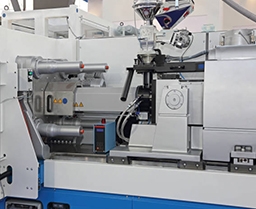Injection molding is the ideal method of processing. Why? We compared injection molding with several other molding methods, let’s take a look.
Ⅰ. Comparison of precision plastic injection and extrusion molding
Injection molding is one of the most popular methods for forming 3D shaped plastics. It is based on the method of molten die casting and consists of a clamping unit and an injection unit.
Plastic injection molding
① Used to make three-dimensional objects.
② Minimize waste and be able to recycle materials.
③ Ability to create detailed features and complex geometries.
④ Enhance the strength of the parts after molding.
⑤ Can use a variety of plastic types at the same time.
Extrusion
This technique extrudes or extrudes material through a die to create shapes using constant cross-sections such as window sections, straws, pipes, and seals. This method is used to form 2D shapes.
Some of the advantages of the extrusion process are:
① Shape hard and brittle materials.
② Facilitates the creation of atypical cross-sections.
③ Ensure the smooth surface of the final product.
④ Changes after the product is taken out from the extruder.
⑤ Can produce complex shapes with different thicknesses, textures and colors.
Now that you know the differences and benefits between plastic and molding, you can make an informed choice about the best technology. Plastic injection molding is one of the preferred methods of manufacturing parts because it offers several advantages over other plastic molding methods – it is simpler, more reliable and extremely efficient.
Ⅱ. Comparison of precision plastic injection and compression molding
There are a few things to consider when comparing compression to china plastic injection.
1. Materials
While both processes support a wide variety of plastics, they both have some peculiarities. The following materials are generally the best choices for compression molding: dially phthalate (DAP), thermoset polyester, epoxy, sheet molding compound (SMC), vinyl ester, phenolic, silicone.
On the other hand, material choices for injection molding include: polyethylene, polystyrene, nylon, polypropylene, acrylonitrile butadiene styrene (ABS), polycarbonate.
2. Process
The compression molding process is relatively simpler. This simplicity may be due to the low number of components involved. Such components include raw materials, heated molds, and top plugs.
Injection molding, on the other hand, requires feed hoppers, injection and clamping units, heaters, hydraulic cylinders, and sometimes other components. The injection molding process first converts raw materials into processable pellets or resins before filling them into hoppers.
3. Production capacity
Injection molding is often ideal for small batch production. Injection molding is best when your application does not depend on multiple prototypes of the same type.
Meanwhile, compression molding is best suited for mass production. Suppose you want to develop multiple prototypes simultaneously within a deadline. In this case, you should choose compression molding. It enables you to perform the required quality assurance checks in a short period of time.
4. Precise
Another advantage of injection molding compared to compression molding is that no post-processing is required. This is possible due to dimensional accuracy.
5. Model complexity
Injection molding can produce more complex designs and models than compression molding. So you can easily try out different design ideas with custom injection molding.
6. Length of delivery time
Although compression molding is best for high-volume production, the process has significantly longer lead times than injection molding. The injection molding process is shorter and more reliable for customers who need faster prototype testing.
7. The shape of the final product
Injection molded products are more complex. These products usually have different wall thicknesses. They can also be a combination of various shapes. In contrast, compression molding can make simple block products.
Ⅲ. Comparison of precision plastic injection and blow molding
Blow molding is a special type of plastic processing used to make hollow plastic parts. The extrusion form of blow molding is a manufacturing process in which plastic is melted and extruded into a mold. This process is specifically designed to produce large quantities of hollow one-piece objects.
Some examples of parts and products developed through extrusion blow molding include water bottles, lotion and other small bottles, auto parts, coolers, milk jugs, or any other type of hollow object.
On the other hand, injection molding is a manufacturing process used to make solid plastic parts. This process often requires extensive up-front engineering and design to develop detailed tooling or dies.
Injection production molding is ideal for high-volume orders and high-volume production of identical parts. With this molding process, the mold is the key to creating perfect, precision parts. Precision costs generally make injection molds more expensive than blow molds.
Understanding the differences between these two manufacturing processes and knowing which method is best for your product production is critical to all aspects of your prototyping, planning, manufacturing, and costing. If you need more knowledge, you can follow us.
Zhongde’s scientific injection molding process helps you reduce design risks, with the support of many senior project managers and engineering experts, communicate in all project stages from design to production, minimize costs, if you need injection molding services, welcome to consult All virtues.




